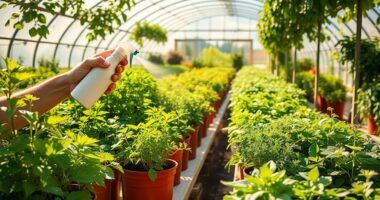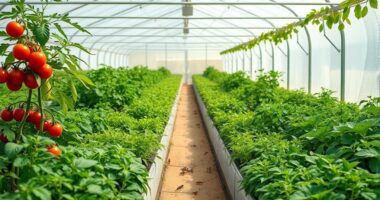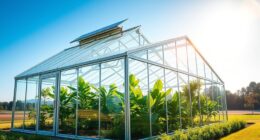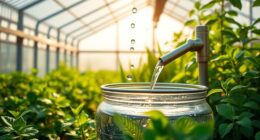To prevent aphid infestations in your greenhouse, regularly inspect young plant tips and stems. Use yellow sticky cards to monitor flying aphids and establish sentinel plants to gauge infestation levels. Maintain sanitation by removing debris and controlling weeds, and manage nutrients wisely by avoiding excess nitrogen. Consider biological controls, and embrace integrated pest management practices. By implementing these strategies, you'll protect your plants from aphids while ensuring a healthy ecosystem. Discover further steps to enhance your greenhouse management.
Key Takeaways
- Conduct regular visual inspections of plants to identify early signs of aphid presence, such as distorted leaves and honeydew.
- Implement strict sanitation practices by removing plant debris and controlling weeds to eliminate potential aphid habitats.
- Utilize yellow sticky cards to monitor for winged aphid populations and ensure timely control measures are taken.
- Avoid excessive nitrogen in fertilization to prevent soft plant tissue that attracts aphids, opting for balanced nutrient management instead.
- Embrace Integrated Pest Management (IPM) by combining biological, cultural, and chemical methods to sustainably control aphid populations in your greenhouse.
Understanding Aphids and Their Impact

Aphids, though small, can have a big impact on your garden or greenhouse. These soft-bodied insects come in various colors, including green, black, and pink. They use their piercing-sucking mouthparts to feed on plant sap, primarily phloem, which can lead to stunted growth and distorted leaves.
As they suck sap, they also excrete honeydew, attracting other pests and promoting harmful sooty mold. Additionally, aphids can transmit plant viruses, further jeopardizing your plants' health.
Their life cycle allows them to reproduce rapidly, especially in warm conditions, making infestations difficult to control. Understanding their anatomy, diet, and impact on plants is essential for effective prevention and management strategies in your greenhouse.
Effective Detection and Monitoring Techniques

Detecting aphid infestations early can make a significant difference in managing their impact on your plants. Regular visual inspections are essential, focusing on young growing tips, stems, and buds.
Establish sentinel plants to monitor control measures over time. Look for signs like white cast skins, honeydew, and black sooty mold.
Use yellow sticky cards to detect winged aphids, placing them above the crop canopy or near vents for ideal monitoring. Count and replace these cards weekly to maintain accuracy.
Combine sticky cards with visual inspections for thorough coverage. Train your staff in aphid identification and maintain detailed records of monitoring results to adapt your strategies as needed.
Early detection is key to effective management.
Importance of Sanitation Practices

While you mightn't think of sanitation as a top priority, maintaining cleanliness in your greenhouse is essential for preventing aphid infestations.
Start by removing plant debris, as it eliminates potential hiding spots for aphids and reduces the chance of them surviving and multiplying. Regularly clean up dead or dying vegetation to minimize pest insects.
Eliminating plant debris is crucial for reducing aphid populations and preventing infestations in your greenhouse.
Don't forget about weed control; weeds can harbor aphids, so remove them from under benches and around the greenhouse.
Clean and disinfect equipment after each use to stop pests from migrating.
Finally, screen doors and vents to prevent aphids from entering, and consider quarantining new plants to catch any pests before they can affect your main crop.
Nutrient Management Strategies

Effective nutrient management is essential for keeping aphid populations in check, as it directly influences plant health and resilience.
Start by avoiding excessive nitrogen, which promotes soft tissue that attracts aphids. Instead, use balanced fertilizers to support overall growth without over-stimulation.
Slow-release fertilizers can help minimize nutrient leaching and reduce aphid populations by preventing luxury consumption. Consider organic fertilizers as a low-impact option.
Monitor your plants regularly to fine-tune your fertilizer applications. Implement controlled release rates tailored to growth stages and apply water-soluble fertilizers moderately.
Rotate between different fertilizer types to maintain soil health and prevent imbalances, ensuring your plants remain robust and less appealing to aphids.
Utilizing Biological Control Methods

Utilizing biological control methods can be a game changer in managing aphid infestations. By introducing natural predators like ladybirds, lacewings, and parasitic wasps into your greenhouse, you can effectively reduce aphid populations.
Ladybird larvae, in particular, are voracious eaters that devour many aphids. Parasitic wasps lay eggs inside aphids, leading to their demise, while predatory midges can also help maintain low aphid numbers.
To attract these beneficial insects, plant nectar-rich flowers like daisies and marigolds around your greenhouse. Timing is vital; release these predators early to prevent aphid outbreaks.
Implementing Integrated Pest Management (IPM)

Implementing Integrated Pest Management (IPM) can greatly enhance your greenhouse's ability to combat aphid infestations. By combining biological, cultural, physical, and chemical methods, IPM minimizes environmental impact while reducing pest populations.
Start with regular monitoring using sticky cards and indicator plants to identify aphids and assess their levels. Accurate pest identification is essential for tailoring your control strategies effectively. Keep detailed records of pest activity and control measures, allowing you to adjust your approach seasonally.
Using lower toxicity pesticides and biorational options supports a sustainable environment. This strategic approach not only reduces chemical use but also promotes biodiversity, leading to potential cost savings for you as a grower. Additionally, understanding local flora can aid in identifying natural predators that help control aphid populations.
Embrace IPM to maintain a healthy greenhouse ecosystem.
Cultural and Mechanical Control Measures

While aphid infestations can threaten your greenhouse, employing cultural and mechanical control measures can considerably reduce their impact.
Start by rotating your crops regularly to disrupt aphid life cycles and prevent population growth. Guarantee proper plant spacing to avoid overcrowding, and manage nutrients to reduce soft plant tissue that aphids love.
Regularly rotating crops and ensuring proper spacing can effectively disrupt aphid life cycles and curb their population growth.
Consider using resistant plant varieties and practice good sanitation by removing debris and weeds.
For mechanical control, install insect screens to block aphids from entering, and use a vacuum to gently remove them from plants.
Pruning infested plants and spraying water can also help dislodge aphids.
Finally, employ physical barriers like reflective mulches to confuse and deter these pests, keeping your greenhouse healthier.
Establishing Monitoring Thresholds for Control
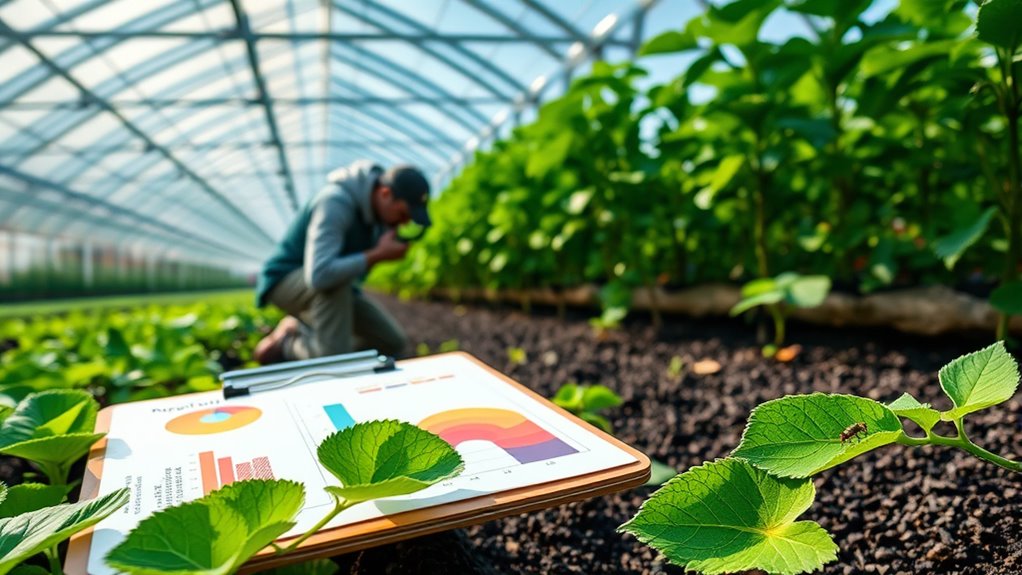
Establishing monitoring thresholds is crucial for managing aphid populations effectively, as early detection can greatly mitigate their impact on your plants.
Regularly inspect your greenhouse plants and use yellow sticky traps to catch winged aphids, which indicate rising populations.
Although action thresholds are tricky due to aphids' rapid reproduction, consistent monitoring allows you to identify infestations early.
Integrating these monitoring techniques with your pest management strategy guarantees a thorough approach.
Remember, good hygiene and proper plant care can strengthen your defenses.
Frequently Asked Questions
Can Aphids Cause Harm to Indoor Plants as Well?
Yes, aphids can definitely harm your indoor plants.
These tiny pests suck sap from young growth, causing leaves to crinkle or stunt. You might notice sticky honeydew on the leaves, which attracts ants and promotes sooty mold growth, further inhibiting photosynthesis.
Heavy infestations can distort growth and lead to leaf drop. Plus, they can transmit viral diseases, affecting the overall health of your plants.
Regular inspection is key to catching them early.
What Are the Signs of a Severe Aphid Infestation?
If you're dealing with a severe aphid infestation, you'll notice several telltale signs.
Look for white cast skins on your plants, which indicate molting. You might see sticky honeydew, attracting ants and promoting sooty mold growth.
Check for black sooty mold on leaves and distorted young growth, curling from aphid feeding.
Regular visual inspections and monitoring with yellow sticky cards will help you catch these signs early and address the issue promptly.
How Quickly Can Aphid Populations Grow Under Ideal Conditions?
You might think aphids take time to multiply, but they can actually grow incredibly fast under ideal conditions.
In just a week, their populations can double, and a single female can produce up to 100 offspring in about 30 days.
With warm temperatures and plenty of food, their numbers can skyrocket, reaching billions by the end of a growing season.
It's essential to monitor these factors to keep populations in check.
Do Aphids Affect the Taste of Fruits and Vegetables?
Aphids don't typically affect the taste of fruits and vegetables.
While they suck sap and can weaken plants, there's no direct evidence that they alter flavor profiles.
However, their honeydew secretion can attract other pests and lead to sooty mold, which might impact appearance and plant health.
Are There Any Natural Repellents for Aphids?
Yes, there are several natural repellents for aphids you can use.
Consider planting pungent-smelling herbs like garlic, onions, or sage alongside your vulnerable plants. Petunias also work well to deter these pests.
You might want to try neem oil or a soap and water mixture as sprays, too. Additionally, essential oils like peppermint and clove can be effective.
These options not only help repel aphids but also support a healthier plant environment.
Conclusion
In summary, preventing aphid infestations in your greenhouse is essential for maintaining healthy plants and maximizing yields. Did you know that aphids can reproduce at an astonishing rate, with a single female producing up to 80 offspring in just one week? By implementing effective monitoring techniques, practicing good sanitation, and utilizing biological controls, you can keep these pests at bay. Remember, a proactive approach is key to ensuring your greenhouse thrives without the threat of aphids.


